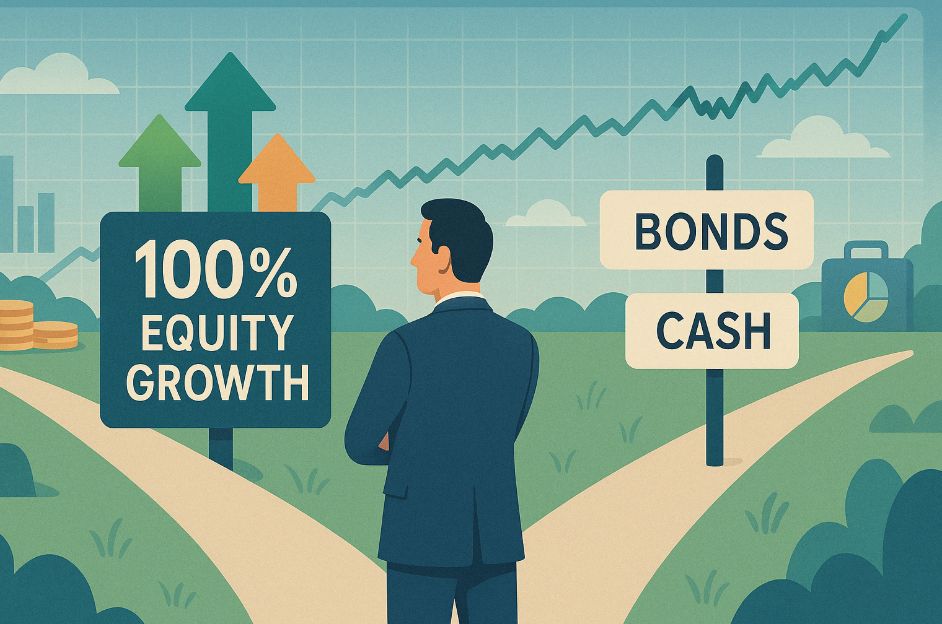In the dynamic world of investing, choosing the right fund can feel like navigating a maze of jargon, graphs, and speculation. For UK investors seeking long-term growth, the Vanguard LifeStrategy 100% Equity Fund Accumulation has become a widely recognised name. But as its title suggests, this fund is fully exposed to the global equity market with no bonds or fixed-income assets as a cushion.
The question then arises: is this fund a bold and sensible choice for growth, or an overly aggressive gamble in today’s economic climate?
This article explores the structure, benefits, and risks of the LifeStrategy 100% Equity Fund Accumulation, helping investors determine whether it fits their financial goals and risk tolerance.
What is the LifeStrategy 100% Equity Fund Accumulation?

The LifeStrategy 100% Equity Fund Accumulation is part of Vanguard’s suite of multi-asset funds designed for simplicity and long term growth. Unlike balanced funds that include a mix of stocks and bonds, this particular version is entirely invested in equities, meaning it carries a higher potential for both growth and volatility.
Understanding Accumulation Units
The term “accumulation” refers to how dividends from the underlying equities are handled. In accumulation funds, dividends are automatically reinvested back into the fund, increasing the overall value of the investment. This contrasts with income units, where dividends are paid out to the investor. The accumulation model is ideal for investors focused on compounding growth over time.
Vanguard’s Investment Philosophy
Vanguard’s approach is passive, meaning it doesn’t try to outperform the market through active stock picking. Instead, it tracks major indices, giving broad exposure to global markets with low costs and minimal trading.
How Does the Vanguard LifeStrategy 100% Fund Work for UK Investors?
This fund is structured to offer a globally diversified equity portfolio. It holds a mixture of index funds that represent companies from developed and emerging markets.
The Role of Passive Investing
Passive investing is a key feature of this fund. By tracking indices such as the FTSE Global All Cap Index, the fund captures returns from thousands of companies worldwide, without making frequent trades or speculative bets.
Global Diversification
The LifeStrategy 100% fund includes equity exposure from North America, Europe, Asia-Pacific, and emerging markets. This diversification helps spread the risk across geographies and sectors, although it’s still tied to the fortunes of the global stock market.
Why Might Investors Choose a 100% Equity Allocation Strategy?
Some investors gravitate towards an all-equity strategy for its potential to generate higher long-term returns compared to funds that include bonds.
Long-Term Growth Potential
Historically, equities have outperformed bonds and cash over extended periods. For young investors with decades ahead before retirement, a 100% equity strategy might offer the best path to capital growth.
High Risk Tolerance and Time Horizon
The longer the investment horizon, the more time there is to recover from market downturns. Investors with a high tolerance for risk. who can remain invested during volatile periods may find this strategy suitable.
What Are the Main Risks of Investing in a 100% Equity Fund?

While the upside of equities is appealing, the downside is equally significant. A portfolio with no bonds lacks the stabilising effect they provide during market downturns.
Market Volatility
Equity markets are inherently volatile. The LifeStrategy 100% fund can experience steep declines during economic shocks, as seen during the 2008 financial crisis and the COVID-19 pandemic.
Emotional Decision-Making
Investors without a clear understanding of risk may panic and sell during downturns, locking in losses. This emotional response undermines the long-term nature of the strategy.
How Has the LifeStrategy 100% Fund Performed Over Time?
The fund has generally delivered strong returns over the long term, aligning with its equity-focused strategy. However, short-term fluctuations can be significant.
Performance Overview
Below is a summary of the fund’s historical performance, compared to its lower-risk siblings in the LifeStrategy range.
| Fund | 1-Year Return | 3-Year Return (Annualised) | 5-Year Return (Annualised) |
| LifeStrategy 100% | 12.4% | 9.1% | 7.6% |
| LifeStrategy 80% | 8.9% | 6.7% | 6.1% |
| LifeStrategy 60% | 6.3% | 4.9% | 5.2% |
Context for Performance
These figures show the reward for taking on additional risk, especially over longer time horizons. However, they also highlight that during downturns, the 100% fund will likely fall harder than its more balanced counterparts.
Who Is the LifeStrategy 100% Equity Fund Best Suited For?
The suitability of this fund depends on the investor’s financial situation, goals, and temperament.
Ideal Investor Profile
Typically, it suits younger investors, those saving for retirement through a Stocks and Shares ISA, or individuals who are decades away from needing their capital. These investors can afford to ride out market turbulence.
Long-Term Commitment
Patience and discipline are essential. Since the fund does not include lower-risk assets like bonds, investors need to remain focused on their long-term goals, resisting the urge to react to short-term market noise.
How Does LifeStrategy 100% Compare with Other Equity Funds in the UK?

There are numerous options available for UK investors seeking equity exposure. So how does this fund stack up?
Fees and Costs
Vanguard keeps fees low the ongoing charges figure (OCF) for LifeStrategy 100% is just 0.22%, significantly cheaper than many actively managed funds. Over time, lower fees can make a substantial difference in total returns.
Diversification and Performance
Compared to single-market funds like FTSE 100 or FTSE All-Share trackers, LifeStrategy 100% offers greater global diversification, which reduces country-specific risk.
Risk/Reward Ratio
While single-market funds can be riskier due to concentration, the 100% equity fund spreads this risk globally, albeit still maintaining full exposure to equity markets.
What Should You Consider Before Investing in LifeStrategy 100%?
Despite its simplicity, the LifeStrategy 100% fund demands careful consideration.
Risk Tolerance Assessment
Investors must be honest about how they would react if their portfolio dropped by 20% or more. If such a scenario would cause panic, this fund might not be suitable.
Platform and Transaction Fees
While Vanguard’s fees are low, investors using third-party platforms may incur additional costs. It’s important to factor these into the total expense.
Rebalancing and Strategy
One of the benefits of this fund is that Vanguard automatically rebalances the portfolio, maintaining the target allocation. This makes it a good choice for “hands-off” investors.
How Does Reinvesting Dividends Impact Long-Term Returns in the LifeStrategy 100% Equity Fund?
Reinvesting dividends is a fundamental driver of long-term wealth generation, especially in a fund like the LifeStrategy 100% Equity Accumulation. Unlike income units, where dividends are paid out to the investor, accumulation units automatically reinvest those earnings back into the fund. Over time, this reinvestment leads to compound growth a phenomenon where gains generate their own gains.
The Power of Compounding
The impact of dividend reinvestment may seem small in the short term, but over years or decades, the benefits become substantial. For example, if the fund pays a 2% dividend yield annually and this is reinvested, the growth accelerates each year. That reinvested 2% earns its own returns, multiplying gains over time without any need for the investor to take action.
Why Accumulation is Ideal for Long-Term Investors?
For investors who don’t need immediate income, the accumulation version of the LifeStrategy 100% fund offers a more efficient growth mechanism. It eliminates the need to manually reinvest dividends and removes the risk of letting dividend payments sit as uninvested cash.
Over the long haul, this translates into a larger investment pot, especially for those using the fund in tax-advantaged accounts like ISAs or SIPPs.
How Can Investors Mitigate Risk When Investing in a 100% Equity Fund?

While the LifeStrategy 100% Equity Fund Accumulation is inherently high risk due to its full equity exposure, there are practical strategies investors can adopt to reduce the emotional and financial risks involved.
Diversify Beyond the Fund
Although this fund offers global diversification within equities, investors can reduce their overall portfolio risk by holding additional asset types in separate accounts. For example, maintaining a cash reserve or investing in a bond fund elsewhere can provide financial flexibility during market downturns.
Invest Regularly Through Pound-Cost Averaging
By investing a fixed amount regularly monthly, for instance investors naturally buy more units when prices are low and fewer when prices are high. This approach, known as pound-cost averaging, helps to smooth out the effects of market volatility over time and reduces the temptation to time the market.
Keep Emotions in Check
Arguably the most critical element of risk management is mindset. Investors need to stay disciplined, especially during downturns. Historically, equity markets recover over time, and those who stay invested tend to come out ahead. Setting clear financial goals and reviewing portfolios only periodically can help remove emotional biases from investment decisions.
Conclusion
The LifeStrategy 100% Equity Fund Accumulation offers a compelling investment option for those seeking long-term growth and who are comfortable with the associated risks. Its low fees, automatic diversification, and reinvestment of dividends make it a smart option for passive investors. However, the lack of bonds means it’s not for the faint-hearted.
For the right investor one who has a long horizon, strong nerves, and clear financial goals this fund could be the perfect fit. But for others, a more balanced allocation might better suit their needs.
FAQs About LifeStrategy 100% Equity Fund Accumulation
What is the difference between accumulation and income units?
Accumulation units reinvest dividends back into the fund to boost its value, while income units pay the dividends directly to the investor.
Is Vanguard LifeStrategy 100 good for retirement planning?
It can be ideal for early-stage retirement planning due to its growth potential, but as retirement nears, investors might want to reduce equity exposure.
Can I lose all my money in a 100% equity fund?
While it’s unlikely to lose everything due to diversification, significant losses during market crashes are possible. Recovery requires time and discipline.
How often does Vanguard rebalance the LifeStrategy 100% fund?
Vanguard rebalances the fund quarterly to maintain its 100% equity allocation, ensuring consistent exposure to the target asset mix.
What is the minimum investment in LifeStrategy 100 UK?
The minimum investment through Vanguard UK is £500 for a lump sum or £100 per month for regular investments.
Are there any hidden fees with Vanguard LifeStrategy funds?
No hidden fees are reported. The fund’s OCF is clearly stated, though platform charges may apply depending on where you invest.
Is LifeStrategy 100 better than other Vanguard funds?
That depends on your risk tolerance and investment goals. For aggressive growth, it’s a strong option, but other funds offer more balanced risk.









Leave feedback about this